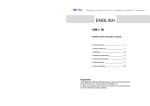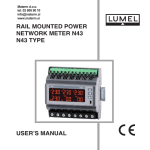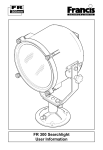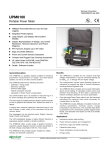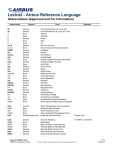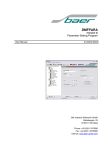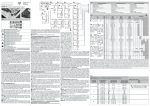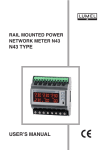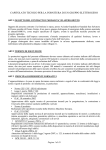Download Man WM396 11-10.eng
Transcript
2 Index CARLO GAVAZZI WM3-96 32bit µ-Processor based power quality analyser with modular housing for Plug and Play modules FW rev. 12 Instruction manual: INDEX TO BEGIN WITH ................................................................ 5 ■ The main programming parameters .......................... 5 ■ Front panel description ............................................. 6 ■ Display adjustment .................................................... 6 DISPLAYING OF THE VARIABLES ................................... 7 ■ Page “00”, starting page ........................................... 7 ■ How to scroll the display pages ................................ 8 ■ How the F key changes function depending on the display page .............................................................. 8 ❏ Pages from “00” to “13”: displaying of the variables ... 8 ❏ Pages from “14” to “18”: displaying of the MIN and MAX values ................................................. 8 ❏ Pages from “19” to “24”: displaying of the harmonic analysis .............................................. 9 ❏ Displaying of the Energy meters ....................... 10 ❏ Page “25”: displaying of the total energy meters ......... 10 ❏ Page “26”: displaying of the partial energies .... 10 ❏ Page “27”: displaying of the instrument’s configuration 11 ❏ Displaying with access to the pass code .......... 11 ❏ Pass “1000”: displaying of the recorded events 11 ❏ Pass “999”: energy consumption storage ......... 12 LET’S START ................................................................. 13 ■ Main menu .............................................................. 13 ■ Changing the password .......................................... 14 ■ Electrical system ..................................................... 14 ■ CT ratio ................................................................. 15 ■ VT ratio ................................................................. 16 ■ Display page ........................................................... 16 4 ▲ ▲ How to use the symbols 4 Index 3 ■ MIN MAX values ..................................................... 17 ■ Selecting the events ................................................ 18 ■ Average values calculation .................................... 19 ENERGY METERS MANAGEMENT ................................ 22 ■ Access to the management menu of the energy meters .... 22 ❏ Single tariff management .................................. 22 ❏ Dual tariff Management: whole year ................. 22 ❏ Programming of the holidays period ................. 25 ❏ Multi-tariff management of the energy meters ..... 27 ❏ Reset of the energy meters .............................. 28 OUTPUTS / OTHER SETTINGS ...................................... 29 ■ Displaying of the harmonics .................................... 29 ■ Clock setting ........................................................... 30 ■ Digital outputs ......................................................... 30 ❏ Pulse output ...................................................... 31 ❏ Alarms ............................................................... 32 ❏ Diagnostics ....................................................... 34 ❏ Remote control ................................................. 34 ■ Analogue outputs .................................................... 35 ■ Serial outputs .......................................................... 36 ■ Digital filter .............................................................. 37 ■ Language ................................................................ 37 USEFUL INFORMATION .................................................. 38 ■ What is ASY? .......................................................... 41 INSTALLATION ................................................................ 41 ■ Preliminary operations ............................................ 43 ■ Before mounting the modules ................................. 43 ■ Overall dimensions and panel cutout ...................... 45 ■ Mounting ................................................................. 45 ■ Position of the slots and relevant modules ............. 46 ■ Available modules ................................................... 46 ❏ Analogue output modules ................................. 46 ❏ Digital output modules ...................................... 48 ❏ Other input/output modules .............................. 48 ❏ Power supply modules ..................................... 49 ■ Connections of optional modules ............................ 49 2 4 ▲ ▲ Displaying of the variables 7 4 Index ❏ V/mA single analogue outputs .......................... 49 ❏ V/mA dual analogue outputs ............................. 49 ❏ Relay output ..................................................... 50 ❏ Open collector output ....................................... 50 ❏ Digital inputs ..................................................... 50 ❏ RS485 serial output .......................................... 51 ELECTRICAL DIAGRAMS ............................................... 52 ■ Electrical connection diagrams ............................... 52 ❏ Three-phase connection, Balanced load .......... 52 ❏ 4-wire three-phase connection, unbalanced load 53 ❏ 3-wire, three-phase Aron connection , .................. unbalanced load ................................................ 54 ❏ Single-phase connection .................................. 55 TECHNICAL FEATURES ................................................. 56 ■ General features ..................................................... 56 ■ Input specifications ................................................. 56 ■ Over-load protection ............................................... 58 ■ Key-pad ................................................................. 58 ■ Output specifications ............................................... 58 ■ Software functions .................................................. 61 ■ Harmonic distortion analysis ................................... 62 ■ Energy Management ............................................... 63 ■ Power supply specifications .................................... 64 ■ General specifications ............................................. 64 HOW TO USE THE SYMBOLS Go to the page where the previous main subject is described. Go to the page where the subject written on the top of the current page starts. Front panel description 2 ▲ ▲ ▲ Go to the page where the next main subject is described. 6 To begin with 5 ▲ Go to the page where the subject written on the bottom of the current page starts. This symbol indicates a particularly important subject or information. This symbol indicates that more details are given on the current subject. We suggest you to keep the original packing in case it is necessary to return the instrument to our Technical Service Department. In order to achieve the best results with your instrument, we recommend you to read this instruction manual carefully. ■ Main programming parameters Programming of the password Selection of the electrical system Programming of the CT ratio (up to 30,000 A) Programming of the VT ratio (up to 600kV) Selection of the variables for the MIN / MAX detection Programming of the calculation of the integration time period Tariff management Harmonic analysis enabling Clock adjustment (if present) Programming of the pulse output (if present) Programming of the serial and analogue outputs (if present) Programming of the digital filter. Index Displaying of the harmonic analysis 6 ▲ 2 ▲ • • • • • • • • • • • • 9 6 To begin with ■ Front panel description Exit from the menu and cancel the choice you have made. It allows you to access some functions relating to the displayed variables. Scroll to the previous page. Access to programming or settings’ confirmation. Scroll to the next page. Alphanumeric indication by means of a 7-segment graphic LCD (128 x 64 dpi): • of the programming parameters; • of the measured variables; • Total number of energy meters: 4 (9 digits); partial number of energy meters: 48 (6 digits); • time periods: 4 programmable within 24 hours • Programmable seasons: 3 within 12 months ■ Display contrast adjustment In order to get the best readability of the display, hold the keys and pressed simultaneously, until the desired readability is reached; the adjustment is cyclical. The contrast can be adjusted only during the measuring phase (from page 00 to page 27). 5 ▲ ▲ Scroll the display pages 8 7 Displaying of the variables ■ Page “00”, Starting page When the instrument is switched on, the main page of variable displaying is shown. This first page, called page "00", is the only one configurable by the user who can choose the variables to be displayed in the 4 displaying areas. In all the other pages (up to 27 depending on the instrument configuration), the type of variables displayed in the four displaying areas is automatically selected and cannot be changed. In the table on page 41 you can see the contents of all the pages that can be displayed by WM3-96. Measured variables Clock Number of the displayed page The bottom part of the display, where the status of the digital outputs is indicated, is common to all the pages. If the outputs are not present, only an empty black rectangular frame is shown; if the outputs are present, the display will show a letter followed by a number. Four different letters may appear: "P" Indicates a pulse output. "A" Indicates an alarm output. In this case the letter can be white in a black background to indicate that the output is in alarm, or black in a white background to indicate that the output is not in alarm. "D" Indicates a diagnostic output. This is a particular type of alarm that is activated when the neutral wire connection is missing. The alarm is active when the background is black, while the alarm is not active when the background is white. "R" Remote control is activated (see Remote Control on page 34). The number that follows the letter is the progressive number of the output (from 1 to 4). Pass 999 12 ▲ ▲ To begin with 5 12 8 Displaying of the variables ■ How to scroll the various pages To scroll the various pages, use the and keys. Pressing the key in any one of the display pages, you access to the programming phase. The key, on the contrary, has various functions depending on the selected page. ■ How the F key changes function depending on the display page ❑ Pages from "00" to "13" (04 in single phase mode) Displaying of the variables key enabled if the alarm latch function is activated, access to the reset of the latch alarms. To reset the latch alarm press the key; after that a message will appear "WILL YOU RESET THE LATCH ALARMS?": if you choose you will enable the reset procedure, if you choose there won’t be any reset. The reset of the latch alarm is only available if the alarm event is finished. ❑ Pages from "14" to "18" (from 05 to 09 in single phase mode). Displaying of the MIN and MAX values The key is active, that means that you have access to the reset function of the “MIN” and “MAX” values. To reset the "MIN/MAX" recording, proceed as follows: enter the function by pressing the key, after that a message will appear: "WILL YOU RESET MIN/MAX VALUES, WILL YOU CONTINUE?" If you choose there won’t be any reset, if you choose the reset will not be made. The (moves from left to right) and (moves from right to left) keys allow you to select the value that you want to reset; to confirm the reset press the key. To exit the function press the key again. Energy meter pages 7 12 ▲ ▲ Index 3 10 Displaying of the variables 9 ❑ Pages from "19" to "24" (10 to 11 in single phase mode) Displaying of the harmonic analysis When the instrument is supplied, these pages are not enabled, see key is active, access to the detailed page 29 to enable them.The analysis of the harmonics. After pressing the key, a pointer appears along the horizontal axis (see figures below). To display the data relating to the single harmonics move along the histogram using (moves from left to right) and (moves from right to left) the keys. For each harmonic the instrument measures the % value with reference to the fundamental and the single harmonic angle between the "V" harmonic and the "A" harmonic of the same order. SIMPLE ANALYSIS: Line phase being measured (L1-L2-L3) and relevant voltage or current value Total harmonic distortion and relevant value in percentage DETAILED ANALYSIS: Harmonic order (h1 to h50) of the phase being measured (L1-L2L3) and relevant absolute current or voltage value of the harmonic. Harmonic order (from h1 to h50), relevant conventional sign (– or +) and value of the harmonic given in percentage. The pointer shows which harmonic is being measured Phase angle between the voltage and current harmonic of the same order: a phase angle between 0° and 90° and between 270° and 360° corresponds to a generated harmonic; an angle between 90° and 180° and between 180° and 270° corresponds to an imported harmonic. Page 00 ▲ Access to the main menu 7 12 ▲ 7 13 10 Displaying of the variables 0° Generated Harmonics: 270° 90° Imported 180° This angle is displayed only if the measurements are taken in a three-phase system with neutral. ❑ ❑ Pages relating to the energy meters Page "25" (12 in single phase mode) Displaying of the total energy meters key disabled. ❑ Page "26" (13 in single phase mode) Displaying of partial energies key is active; modification of tariff/displayed period. By pressing the key for the first time, the range and relating to the season is highlighted. By using the keys, it's possible to change the season displayed in that page. Pressing the key another time, the range relating to the period is highlighted. Using the and keys, it's possible to change the tariff period within the displayed season. Pressing the key for the third time, you go back to the measuring page. The changes of season and tariff period only refer to the displaying of the values stored in the corresponding season and period. The changes carried out in this page do not have any influence on the method of tariff management of the instrument; they are only valid for display purposes. Pass 999 7 12 ▲ ▲ To begin with 5 12 11 Displaying of the variables ❑ Page “27” (14 in single phase mode) Displaying of instrument configuration key disabled. Page 27 shows the configuration of the main input (IN) and output (OUT) modules. Alarms (A1-A2-A3-A4). Diagnostics (D1-D2-D3-D4). Pulse outputs (P1-P2-P3-P4). Digital inputs. The letters and numbers between parenthesis are referred to the relevant slot, while the text on their right shows the variable referred to the output. With reference to the digital inputs (DIG.INP.), the ON/OFF status of each one of them is shown. ❑ Displaying with access to the Pass Code ❑ Pass "1000": displaying of recorded events (Only if the RS232+RTC module is present) Press the key: when the instrument asks you for the pass code , set the value "1000"; if the RS232+RTC module is present, the instrument shows you the page where the events are displayed and where the instrument stores, in a chronological order, the alarms that have occurred until that key. moment. To go back to the variable page press the The last event has always the number 1 while the number corresponding to the first event varies, depending on the number of events that have been previously stored. The figure on the following page explains you the meaning of the displayed information. CT ratio 7 12 ▲ ▲ Harmonic analysis 9 15 12 Displaying of the variables Control type: alarm (e.g. A2), diagnostics (e.g. D1), maximum value (MAX), minimum value (MIN). Only for alarms and diagnostics: detection of the abnormal condition (ON) or return to the normal condition (OFF). Variable being controlled. Date of the event. Time of the event. Alarms: value of the ON alarm; Max and MIN logging: maximum and minimum measured values. To reset all the events press the key, to continue the reset procedure press the key: to exit from the reset procedure press the key. ❑ Pass "999": energy consumption storage (Only if the RS232+RTC module is present) The RS232+RTC module allows also the storage of the energy consumption of the previous two months. To enter this function, press the key: when the instrument asks for the pass code , set the value "999": the instrument shows you the page where all the information are stored. System 7 ▲ ▲ Page 00 7 14 Let’s start 13 Use the and keys to show the partial values, to exit press the key. It is very important to verify that, every time the configuration of the instrument (modules and/or associated variables, electrical systems, etc.) changes, the setting of the parameters is according to the new configuration. ■ Access to the main menu Press the key to access to the programming menus from the measuring and displaying phase; when the instrument asks for it, enter the correct password value by means of the and keys; then confirm it pressing the key again. If the password is correct (the default password is 0) you are allowed to access to the main menu of the programming phase. To reset your choice and go back to the measuring mode, press . 1.2.. ..2.1 MENU title Scroll bar Menu Instrument revision Serial number Min/Max values 21 ▲ ▲ Pass 1000 11 17 14 Let’s start ■ Changing the password Measure 1.2.. ..2.1 This function allows you to choose the desired password value (from 0 to 500). Press the key and when the new password value is required, enter the desired value by means of and keys. the The instrument goes back to the main menu, as shown on the figure on the left. To reset your choices and go back to the main menu press . ■ System This function allows the user to select the type of electrical system by choosing among single phase (1phase), balanced three-phase plus neutral (3+N phases bal.), unbalanced three-phase plus neutral (3+N phases unbal), three-phase balanced (3 phases bal) and threephase unbalanced (3 phases unbal). Choose the SYSTEM function by means of the and keys, press to confirm; then select the desired system by means of the and keys and confirm with . Measure VT ratio 13 21 ▲ ▲ Harmonic analysis 9 16 Let’s start 15 To reset the choice and go back to the main menu, press the key. Changing the type of system, all the MIN/MAX values, the events and the partial energy meters are reset. ■ CT ratio Measure 1.2.. ..2.1 This function allows you to select the value of the CT ratio. Example: if the primary of the CT (current transformer) being connected is 300A and the secondary is 5A, the CT ratio corresponds to 60 (obtained from the calculation: 300/5). Choose the function CT RATIO by means of the and keys; press to confirm, then select the desired value by means of the and keys and confirm with . To reset the choice and go back to the main menu, press . Note that when the CT ratio is changed all the MIN/MAX values, the events and the partial energy meters are reset. Energy meters ▲ Average power calculation 13 21 ▲ 10 19 16 Let’s start ■ VT ratio 1.2.. ..2.1 This function allows the user to select the multiplier value of the VT. Example: if the primary of the VT (voltage transformer) being connected is 20kV and the secondary is 100V, the VT ratio will be 200 (given by 20000/100). If there is no VT, the ratio will be “1.0”. Choose the function VT RATIO by means of and ; to confirm press ; then select the desired and keys and value by the confirm with . To reset your choice and go back to the main . menu, press Changing the VT ratio, all the MIN/MAX values, all events and partial energy meters are reset. ■ Display page This function allows you to select the variables to be displayed on page 00. Choose the DISPLAY PAGE function by means of the and keys; press to confirm, then select the desired section of the display using the and keys; Event selection 13 21 ▲ ▲ Pass 1000 11 18 Let’s start 17 Press ; select the variable to be displayed by means of the and keys and confirm it with . To reset your choices and go back to the main menu press . Measure ■ MIN/MAX VALUES This function allows the user to associate some variables to the automatic recording of maximum values (from MAX1 to MAX12) and minimum values (from MIN1 to MIN8). To use this function, proceed as follows: select the MIN MAX VALUES function using the and keys and confirm it with . A new window will appear showing you the list of available memory locations: select the locations using and keys, starting from the MAX1 for the maximum values and MIN1 for the minimum values. Press to open the secondary menu with the list of the available variables to be selected. Average power calculation 13 21 ▲ ▲ CT ratio 15 21 18 Let’s start Scroll the list of the variables using the and keys; once you have selected the desired variable, confirm it using . To reset your choices and go back to the main menu, press . Once you have confirmed the selection, the following message will appear: “YOUR CHOICE WILL RESET THE VARIABLE, WILL YOU CONTINUE? YES/NO”. Note: to enable the MIN/MAX recording function, read carefully the following paragraph, SELECTING THE EVENTS. ■ Selecting the events This function allows the user to enable the events for data logging: • MAX (logging of up to 12 different variables MAX1 to MAX12), see also: MIN MAX VALUES; • MIN (logging of up to 8 different variables MIN1 to MIN8), see also MIN MAX VALUES; • D ”diagnostics” (logging of up to 4 alarms: from D1 to D4), see also: DIAGNOSTIC DIGITAL OUTPUTS • R “remote control” (up to 4 remotely controllable outputs: from R1 to R4), see also REMOTE CONTROL DIGITAL OUTPUTS; • A "alarms" (logging of up to 4 alarms: from A1 to A4), see also: ALARM DIGITAL OUTPUTS; CT ratio ▲ Synchronization 13 21 ▲ 15 20 Let’s start 19 To use this function, select “EVENTS SELECT.” from the main menu using the and keys and confirm it pressing . Use the and keys to select where you want to enable the event (ON) or disable it (OFF). The function of the ONOFF-ON key is cyclical. To go back to the main menu press . ■ Average power calculation This function allows to select the calculation method of the W-VA-cosϕ average value. To enter these functions, select “AVERAGE CALCULATION” from the main menu by means of the and keys and confirm the selection pressing the key. You can now choose the average calculation method, that is you can choose between FIXED and FLOAT SELECTION using the and keys. Confirm your choice using the key. Then, you can set the integration time period; again, use the and keys to set the desired value and confirm it with . To reset your choices and go back 1.2.. ..2. to the main menu, press Energy Meters Management 13 21 ▲ ▲ Min / Max values 17 . 23 20 Let’s start FIXED SELECTION: if, e.g., you set this value at 15 minutes, the instrument calculates and updates the average of the variables (W-VA-PF) every 15 minutes. FLOAT SELECTION: if, e.g., you set this value at 15 minutes, the instrument at first calculates and updates the average of the variable (W-VA-PF) after 15 minutes and then every minute (fixed time). See the diagram that shows the different operating methods (FIXED and FLOAT) on the following page. SYNCHRONIZATION OF THE FIXED OR FLOAT CALCULATION The synchronization of the FIXED or FLOAT calculation can be carried out in three different ways: • without the DIGITAL INPUT and RS232 + RTC modules: the reset and the beginning of the synchronization is carried out as soon as the instrument is powered on; • with the installed DIGITAL INPUT module: the synchronization begins when the digital input modules change state (from ON to OFF or from OFF to ON). Any following change of state will make the synchronization reset and start all over again; • with the RS232+RTC module: the synchronization begins at the exact hour that follows the switch on of the instrument (E.g.: if the instrument is switched on at 10:25, the synchronization begins at 11:00). In case both modules are installed (that is digital inputs and RS232+RTC) the priority will be given to the Digital Input modules. Energy Meters Management 13 21 ▲ ▲ CT ratio 15 22 Let’s start 21 FIXED AVERAGE CALCULATION Where: Pmax is the maximum measured power Pc is the contractual power, t1 is the selected average period FLOAT AVERAGE CALCULATION 13 Holiday period ▲ ▲ Average power calculation 19 25 22 Energy Meters Management ■ Access to the Energy Meters Management Menu TARIFF SELECTION TARIFF SELECTION This function allows you to choose the type of management of the energy meters. Select “ENERGY METERS” from the main menu by means of the and keys; confirm with to access the specific secondary menu. ❑ Single tariff This function sets the Energy meters according to a single tariff which is the same for the whole year. Select SINGLE TARIFF by means of the and keys and confirm your choice with . When you change the type of management, and after the choice is confirmed, the instrument resets the meters and a buzzer sounds. ❑ Dual tariff management of the meters: whole year This selection manages the energy meters with two different tariffs per day and two periods per year. Select DUAL TARIFF from the energy meters menu by means of the and keys and confirm with . Select WHOLE YEAR and confirm with to enter the relevant menu; now you can enter the programming of the daily period as follows: 1- press : the first box (trf=tariff) is highlighted; 2- press again: the TARIFF box will appear on the lower part of the display; now you can choose the tariff (from 1 to 4, e.g.: 1) by means of the and keys; Energy Meters Management 28 ▲ ▲ Min/Max values 17 24 Energy Meters Management 1.2.. ..2.1 1.2.. ..2.1 1.2.. ..2.1 Proceed with the same principle for the following rows. To exit any item use always . 3- press the key again; the “endtariff” hour is highlighted; 4- press the key again; the HOURS box will appear on the lower part of the display; now you can choose the hours - e.g. 8 - by means of the and keys. 5- press the key again; the “end tariff” minutes will be highlighted; 6-press the key again: the MINUTES box will appear on the lower part of the display; now you can set the minutes - e.g. 10 - by means of the and and keys. 7-after the confirmation of the last setting, press and you are back to the selection of the first "trf" parameter you have highlighted. The “starting hour” of the following line becomes equal to the “end hour” you have just selected. Only when the “trf” parameter is highlighted, you can scroll the parameters and modify them: use the key to access to the key to move parameter; use the from left to right and the key to move from right to left. 8- Press to exit the programming of the parameters of the relevant row (no boxes are to be highlighted); 9- press and to select one of the other programming lines; the pointer on the right shows the line where the user can modify the parameters (points from 1 to 7). Reset of the energy meters 22 28 ▲ ▲ Diagrams 21 23 28 24 Energy Meters Management a) the day can be divided into up to 8 different periods connected to up to 4 different tariffs according to the following working principle: 20 22 24 2 trf1 4 18 + kWh - kWh + kvarh - kvarh 6 16 8 14 12 10 1 Imported active energy Exported active energy Imported reactive energy Exported reactive energy The measured energy (partial energy) is placed in TARIFF 1 when the time period is from midnight to e.g. 8:00am, in TARIFF 2 when the time period is from 8:00a.m. to 08:00p.m. and again in TARIFF1 when the time period is from 08:00p.m. to midnight. The total measured energy is the result of the sum of all the partial measures as shown in the figure below: trf1 20 22 24 2 trf1 4 18 + kWh - kWh + kvarh - kvarh 1 + kWh - kWh + kvarh - kvarh 6 16 8 14 12 10 trf2 + kWh - kWh + kvarh - kvarh T 2 b) the starting point of the first time period is always 24:00 (midnight) and cannot be changed; c) the starting point of the following period is always the end hour of the previous time period; d) the daily loop is closed by setting 24:00 as last hour of the last time period (to follow this procedure see point 4 on the previous page), confirm the setting by pressing and to go back to the TARIFF SELECTION menu. 22 Trf holiday period 28 ▲ ▲ Average power calculation 19 26 Energy Meters Management 25 ❑ PROGRAMMING THE HOLIDAY PERIOD To program the HOLIDAY period, proceed in the following way. 10- Choose HOLIDAY in the SEASON menu by means of the 1.2.. ..2.1 1.2.. ..2.1 1.2.. ..2.1 1.2.. ..2.1 On page 26 To reset, press . and keys and confirm with : the HOLIDAY menu will be displayed (see figure on the left); 11-press : the month corresponding to the start date will be highlighted; 12-press : the box for setting the month will be enabled; and to select the 13-use desired month (from 1 to 12); 14-press the key to confirm the selection and move to the next parameter: day setting; 15-press the key again to open the box where the day is to be set; 16-use the and keys to select the desired day (from 1 to 31 depending on the previously selected month); 17-press the key to confirm the selection and move to the next parameter. 21 Display of harmonics 28 ▲ ▲ Dual tariff management 23 29 26 Energy Meters Management To program the “end date” follow the same procedure described above from No. 11 to No. 16. After confirming the “end” day by means of the key, the HOLIDAY box is highlighted to indicate the conclusion of the HOLIDAY period programming cycle. You can also use the (moves from right to left) and (moves from left to right) keys to scroll along the available parameters. pag. 25 1.2.. ..2.1 It’s possible to choose the tariff to be associated to the HOLIDAY period according to the following procedure: From page 25 starting from the box on the previous page, number 10, press the key again: the instrument will display the box shown on the left. Press : the box of the “trf” value is highlighted; key again: the instrupress the ment will display on the lower section the box where the tariff is to be set. Select the desired tariff (from 1 to 4) by means of the and keys and confirm it with . To reset your choices and/or exit the menus, use the key. Meters reset 22 28 ▲ ▲ Diagrams 21 28 Energy Meters Management 27 ❑ MULTI TARIFF This function allows the management of the meters according to many periods per day and three periods per year: WINTER, SUMMER and HOLIDAY. To program the parameters relating to the winter season, simply follow the same procedure (holidays) described on page 25 from No. 11 to No. 17. The parameters of the SUMMER season are automatically set by the instrument as a difference between the previous two periods of the Year. To enable the setting of the daily time periods, press when the WINTER or SUMMER seasons are highlighted. The following settings are the same as the ones described from No. 1 to No. 9 on page 22 and 23. To reset your choices and/or go back to the previous menus, use the key. To program the HOLIDAY period, follow the procedure on page 25 from No. 11 to No. 17. The periods WINTER and SUMMER are conventional seasons mainly used to manage in the best way the different energy costs during the year. The reminds from letter a) to d) are also valid for the MULTI TARIFF function.The next page shows a few examples of programming the various time periods. Pulse output 22 28 ▲ ▲ Holiday period 25 31 28 Energy Meters Management DUAL TARIFF management trf1 20 22 24 2 trf1 4 18 6 16 8 14 12 10 WHOLE YEAR trf start end 1 OO:OO O8:OO 2 O8:OO 2O:OO 1 2O:OO OO:OO 1 TARIFF trf2 As you can see on the figure above, there is a daily division into three periods with two different tariffs. MULTI TARIFF management trf1 trf4 20 22 24 2 trf1 4 6 18 trf3 16 trf2 WINTER trf start end OO:OO O6:OO 1 2 O6:OO O8:OO 3 O8:OO 1O:OO 1 TARIFF 8 14 12 10 trf3 trf2 WINTER trf start end 1O:OO 16:OO 2 3 16:OO 18:OO 4 18:OO 21:OO 1 21:OO OO:OO 2 TARIFF On the picture above you can see four different tariffs which are coupled to seven different periods of the day. ❑ Reset of the Energy meter The “RESET” menu allows you to reset the energy meters. Press to enter the menu, then use and to select the type of reset you prefer. Confirm the selection by means of the key: the instrument displays the following message: PAY ATTENTION, ALL THE METERS WILL BE RESET!! WILL YOU CONTINUE? Digital outputs 22 ▲ ▲ Dual tariff 23 30 Outputs / Other settings To conclude the RESET procedure, press the TARIFF SELECTION menu, press . 29 ; to go back to The reset procedure allows the user to choose among the following different choices: ALL: reset of all the energy meters (imported/ exported energies); TOTAL + : reset of the imported energy meters (+kWh, +kvarh); TOTAL - : reset of the exported energy meters (-kWh, -kvarh); PARTIAL + : reset of the partial imported energy meters (+kWh, +kvarh); PARTIAL - : reset of the partial exported energy meters (-kWh, -kvarh). ■ HARMONIC ANALYSIS This function enables the display of the windows relating to the harmonic analysis. Press to enter the menu; then, use the and keys to select the phase where you want to enable the harmonic analysis. The key allows the user to enable (ON) or disable (OFF) the displaying (the function is cyclical: ON-OFF-ON). To go back to the main menu, press . Alarm parameters 37 ▲ ▲ Multi tariff 27 33 30 Outputs / Other settings ■ Clock setting This function enables the user to set the data relating to date and time. Select CLOCK from the main menu and keys; by means of the then press to enter the menu. Choose the desired function by means of the and keys; Enter the desired secondary menu with . Then set the desired value by means of the and keys and confirm the value with . To reset the choices and go back to the main menu, press . The EURO/USA function allows the user to display the date and time according to the EUROPEAN (EURO, date: day/month/year; time: 24 hours) or AMERICAN (USA, date: month/day/year; time: 12 hours / AM and PM) format. ■ Digital outputs This function enables the user to connect the type of digital output to the slot at the beginning. The instrument indicates if the module is not in the slot with the message “NOT AVAILABLE”; whereas if the module is in the slot, the instrument automatically goes to the digital output menu, where the user can set four different types of output: PULSE OUTPUT, ALARM OUTPUT, Holiday period ▲ Alarms 29 37 ▲ 25 32 Outputs / Other settings 31 DIAGNOSTIC OUTPUT, REMOTE CONTROL OUTPUT. To enter these functions, choose DIGITAL OUTPUT and from the main menu using the keys, then confirm with . The instrument shows a window where the various slots (OUT C0, OUT C1, etc.) and output channels (1, 2, etc.) are shown. Select the desired and keys and confirm with to enter slot using the the output function menu (if the module is not in the slot, the instrument displays NOT AVAILABLE). To reset the choices and go back to the main menu, press . The meaning of the symbols on the display is the following: OUT C0 (1): digital output, SLOT C0, channel 1 OUT C1 (2): digital output, SLOT C1, channel 2 OUT D0 (3): digital output, SLOT D0, channel 3 OUT D1 (4): digital output, SLOT D1, channel 4 ❑ Pulse output This function allows the user to set the parameters of the pulse output. The output can be connected to a specific energy and this energy can be connected to the desired tariff. The measured energy is re-transmitted by means of the pulse output (the pulses/energy ratio of which is and to programmable). Use select PULSES from the list of available outputs; then confirm with and choose from the submenu ENERGY TYPE the energy that you want to be retransmitted, using and : 1.2.. ..2.1 Analogue outputs 29 37 ▲ ▲ Display of harmonics 29 35 32 Outputs / Other settings consumed active energy (kWh +), generated active energy (kWh -), consumed reactive energy (kvarh +), generated reactive energy (kvarh -), press the “ ” key to open the menu of energy/pulse output management. There are five possible selections: TOTAL, output connected to the total energy meter; TARIFF, output connected to the desired tariff type. Confirm with and go back to the digital output menu. To reset the choices and go back to the main menu, press . The multiplyer of the measuring unit (kW,MW) automatically changes according to the CT or VT ratio set by the user. ❑ Alarms This function allows the activation of a static or relay output when an alarm condition is detected. Select ALARM from the DIGITAL OUTPUT menu by means of the and keys, then press to enter the display window of all the alarm parameters: Select the desired variable by means of the and keys, press to confirm and enter the submenus dedicated to the various parameters: •VARIABLE: variables to be connected to the alarm: you can Diagnostic 29 37 ▲ ▲ Multi-tariff 27 34 Outputs / Other settings 33 choose among all the available ones (see on page 43); scroll the variables by means of the and keys and confirm the selection with . The availability (or non-availability) of the variable is clearly indicated on the display. •TYPE: type of alarm: up alarm (UP); down alarm (DOWN); up alarm with latch (UP L): in this case the reset of the output can only be manual; down alarm with latch (D.L.): in this case the reset of the output can only be manual; down alarm with disabling at power ON (D.DO). Choose the desired alarm type by means of the and keys and confirm it with . •SET ON: ON-alarm set-point. Select the value of the variable by means of the and keys and confirm it with . •SET OFF: OFF-alarm set-point. Select the value of the variable by means of the and keys and confirm it with . •OUT: normally energized alarm (NE) or normally de-energized alarm (ND). Choose the desired function by means of the and keys and confirm it with . •DELAY: delay on alarm activation. Select the desired delay value in seconds by means of the and keys and confirm it with . Only in case of controls of the power variables, it’s necessary to select the resolution (position of the decimal point) of the alarm set-point’s value. Pulse output ▲ Language 29 37 ▲ 31 37 34 Outputs / Other settings ❑ Diagnostic In a 3-phase unbalanced-load system, this function controls the presence of the neutral connection. If the connection to the neutral is not detected, the instrument activates an alarm. Select “DIAGNOSTIC” by means of the and keys, then press to confirm it. To reset your choice and go back to the main menu, press . ❑ Remote control This function enables the control of the digital outputs by means of the RS485/RS232 communication port instead of using the instrument’s alarm. The outputs can be activated by a PC or PLC by sending special commands. Select the REMOTE CONTR. function by means of the and keys and confirm pressing the key: the instrument will go back to the digital output menu. To reset your choice and go back to the main menu, press Serial output 29 37 ▲ ▲ Display of harmonics 29 . 36 35 Outputs / Other settings ■ Analogue outputs Select ANALOG OUTPUTS from the and main menu by means of the keys; confirm it with to enter the various parameters: OUT A0: Analogue output, SLOT A0, channel 1; OUT A1: Analogue output, SLOT A1, channel 2; OUT B0: Analogue output, SLOT B0, channel 3; OUT B1: Analogue output, SLOT B1, channel 4. Select the desired parameter by and keys and means of the confirm with to enter the relevant submenus: •VARIA: variable to be connected to the output; choose among the available ones (see on page 43) by means of the and keys and confirm the selection with . The availability (or non-availability) of the variable is clearly indicated on the display. •MIN O: value expressed as % of the “zero” of the output range (0-20mA, 0-10V, etc.) that is generaged by the minimum measured value (Min In). Select the desired value by means of the and keys and confirm it with . •MAX O: value expressed as % of the full scale of the output range (0-20mA, 0-10V, etc.) that is generated by the measured value (Max In). Select the desired value by means of the and keys, and confirm it with . Useful info 29 37 ▲ ▲ Alarm parameters 33 39 36 Outputs / Other settings •MIN IN: minimum value of the variable input range. Select the and keys and desired value by means of the confirm it with . •MAX IN: maximum value of the variable input range. Select the desired value by means of the and keys and confirm it with . To exit from any of the menus, press . For further information, see examples No. 1 and 2 on page 38/39. For the resolution of the value to be retransmitted, see the note on page 33. Every time a new selection of the variable connected to the analogue output is made, it is important to check and if necessary program again all the relevant parameters. ■ Serial output This function allows the user to set the parameters of the serial output. Select SERIAL OUTPUT from the main menu by means of the and keys and confirm it with . Select the function you want to set from one of the submenus by means of the and keys and confirm it with . The configurable parameters are the following: • Instrument ADDRESS: from 1 to 255. • BAUD RATE: 1200, 2400, 4800 and 9600 bit/s. • PARITY: no parity, even parity and odd parity. To exit from one of the menus or cancel a selection, press . 1.2.. ..2.1 Useful information 29 37 ▲ ▲ Pulse outputs 31 38 Outputs / Other settings ■ Digital filter 37 Select FILTER by means of and and confirm with . Select the function to be set from one of the submenus by means of the and keys and confirm it with . You can choose among the following 3 selections: • DISPLAY: to select the display of the measurements of the instantaneous variables at 4-digit (max 9999) or 3 1/2-digit (max 1999) • RANGE, to set the operating range of the digital filter. The value is expressed as % of the full scale value. • COEFFICIENT, to set the filtering coefficient of the instantaneous measurements. Increasing the value, also the stability and the settling time of the measurements are increased. Once one of the three parameters has been selected, set the desired value by means of the and keys and confirm it with . To exit the “FILTER” menu, press . For any other info, see “Useful info, Ex. 2 on page 40). ■ Language Select LANGUAGE from the main menu by means of the and keys and confirm with . Select the language to be set from the submenu with the and keys and confirm the selection with . To exit from any of the menus or cancel a selection, press . What’s ASY 29 ▲ ▲ Analogue outputs 35 41 38 Useful information The variables measured by the instrument are correct if the inputs have been connected according to the right polarities (see figure below). Should the connection not be conforming to the right polarities, measuring and retransmission errors may occur, both due to the wrong direction of the current flowing in the primary/secondary of the ammeter transformer being connected. It is however possible to measure and retransmit currents/ powers according to the direction of their flow using correctly the parameters "MIn U./Max U." and "Min IN/Max IN". Example 1: it’s necessary to measure a consumed active power up to 100kW considering that it may either be consumed or generated by the system and retransmitted with a 4 to 20mA signal; the module to be used is AO1026 (2x from 0 to 20 mA) or AO1050 (1x from "MIn U./Max U." and "Min IN/ Max IN".0 to 20 mA) that is to be set as follows: • VARIA.: WΣ (active system power) • MIN U.: 20,0% corresponds to 4mA, the calculation formula is: (100* min. output)/ fullscale output = 100*4mA/20mA= 20% • MAX U.: 100,0% corresponds to 20mA, the calculation formula is: (100* max. output)/ fullscale output= 100*20mA/ 20mA=100% • MIN IN: 0,0 K;the K,M and G multipliers are automatically selected by the instrument depending on the selected VT and CT value; • MAX IN: 100,0 K; the K,M and G multipliers are automatically Example 4 43 ▲ ▲ Alarm parameters 33 40 Useful information 39 selected by the instrument depending on the selected VT and CT value; Example 2: it’s necessary to measure both the consumed active power and the generated active power up to 100kW and retransmit it with a signal from –10 to 10V; the module to be used is AO1033 (2x ±10VCC) or AO1057 (1x ±10VCC). The parameters may be set as follows: • VARIA.: WΣ (active system power) • MIN U.: 0,0% corresponds to -10V; the calculation formula is: (100* min. output) / fullscale output = 100*0V / 20V = 0%; in this case the whole range of the analogue output is to be considered for the calculation, therefore -10 +10 = 20V. • MAX U.: 100,0% corresponds to 10V, the calculation to be carried out is: (100*maximum output)/fullscale output=100*20V/20V=100% • MIN IN: -100K; K,M and G multipliers are automatically selected by the instrument depending on the selected VT and CT value; • MAX IN: 100,0 K; the K,M and G multipliers are automatically selected by the instrument depending on the selected VT and CT value; Therefore, when the power is equal to -100kW, the output will be -10V, when the power is 0, the output will be 0V and when the power is 100kW, the output will be +10V. Example 3: it’s necessary to retransmit the whole range of the values admitted for the PF with a signal from 0 to 20mA. Pay attention to the fact that the variable PF can correspond to the values included between C 0,00 and L 0,00 (for each phase); once these values are retransmitted, they will change into 0 and 20mA. When the PF will correspond to a value equal to 1 being at the centre between C0,00 and L0,00, the output value will correspond to the centre of its scale, that is 10mA. As a consequence, the instrument is to be set as follows: • VARIA: PF L1 (or L2 or L3); Installation 38 43 ▲ ▲ Language 37 43 40 Useful information • MIN U.: 0,0% • MAX U.: 100% • MIN IN: C 0,000; the values entered with a negative sign correspond to C, those entered with a positive sign correspond to L; • MAX IN: L 0,001; the values entered with a negative sign correspond to C, those entered with a positive sign correspond to L; we have chosen to limit “0,001” as minimum value to be set for L , in order to avoid any undesired oscillation of the outputs. Example 4: it’s necessary to stabilize the value of the displayed variable “VL1-N”, that varies from 222.0V and 224.0V, continuing to have an indication of 4 digits. The parameters of the digital filter must be set as follows: • DISPLAY: 4 digits • RANGE: the variable may have variations within the average amplitude value equal to ±0.4% of the full scale of the variable (±0.4/100*250V= ±1V). The parameter “range” that is the action range of the digital filter, will be set at a value which is slightly higher than the percentage amplitude of the fluctuation: e.g.: 0.5%. • COEFFICIENT: if the new value acquired by the instrument is within the action range of the filter, the new displayed value is calculated by summing (algebraically) to the previous value the variation divided by the filtering coefficient. As a consequence, a higher value of this coefficient results in a higher settling time, that means a higher stability. The best result is generally obtained by setting the filtering coefficient at a value equal to at least 10 times the value of the range parameter. In the example: 0,5*10=5. To enhance the stability, you may also increase the filtering coefficient (values within 1 and 255 only). List of variables 38 43 ▲ ▲ Analogue outputs 35 42 41 Useful information ■ What is ASY The ASY variable allows to control the symmetry of the star / delta voltages (for systems without neutrals) and star voltages (for systems with neutral). The variable is calculated as follows: where the first formula is to be applied with delta systems, while the minimum value calculated between the two is to be used for the star systems. It’s very important, as a general rule, to plug in and extract the optional modules only when the instrument is switched off. LIST OF THE DISPLAYED VARIABLE PAGES N∞ 1st variable 00 selectable selectable selectable selectable 01 VL1 VL2 VL3 VL-N ∑ 02 VL1-2 VL2-3 VL3-1 VL-L ∑ 03 AL1 AL2 AL3 An 2nd variable 3rd variable 4th variable 04 WL1 WL2 WL3 W∑ 05 var L1 var L2 var L3 var ∑ 06 VA L1 VA L2 VA L3 VA ∑ 07 PF L1 PF L2 PF L3 PF ∑ Example 2 ▲ Mounting 38 43 ▲ 39 45 42 Useful information The configuration shown in the tables above is only valid for connections to 3-phase systems with neutral. In case of any other system, the type and quantity of the displayed variables will vary. Removal of the modules 38 43 ▲ ▲ Analogue outputs 37 44 43 Useful information List of the available variables: V L1 An VA L3 THDll V2 THD A3 V L2 W L1 VA∑ THDI V2 THDII A3 THDI A3 V L3 W L2 PF L1 THD V3 VL-N∑ W L3 PF L2 THDll V3 An dmd V L1-2 W∑ PF L3 THDl V3 VA dmd V L2-3 var L1 PF ∑ THD A1 PF avg V L3-1 var L2 Hz THDll A1 W dmd V∑ var L3 THD V1 THDl A1 ASY A L1 var ∑ THDll V1 THD A2 A L2 VA L1 THDl V1 THDll A2 A L3 VA L2 THD V2 THDl A2 The availability of the variables depends on the type of electrical system being selected. ■ INSTALLATION ❑ Preliminary operations Before switching the instrument on, make sure that the power supply voltage corresponds to what is shown on the side label of the relevant module. Example: AP1020, Universal power supply input range: 100V...240V DC/AC (50Hz -60Hz) power consumption: 12W / 30VA 1 PHASE serial number: S/N 002700/20345 ❑ Before mounting the modules Each module (input, output and power supply) must be mounted in the proper slot: each module has been conceived to be mounted in one slot only. To know in which slot every module is to be mounted, refer to the figure on page 45. Position of the modules 38 ▲ ▲ What is ASY? 41 47 44 Installation For a correct mounting of the instrument, insert the modules in the relevant slots, then, at the end, enter the central module, which can be a blind type module or an RS232communication module. The central module will help fixing also the other modules in the relevant slots. To remove the modules use a screwdriver as shown in the picture below: Gently depress the two fixing tabs. Direction 1-4. 1 3 2 Remove the central module from its slot: press your thumb towards points 2-5. Extract the central module Take out the other modules. Any other slots that you haven’t used must be filled with the relevant blind plug modules supplied with the instrument. Example 2 ▲ Position of the modules 51 ▲ 39 46 45 Installation ❑ Overall dimensions and panel cut-out ❑ Mounting Insert the instrument (holding its front) and fasten it (from the back) by fixing the two lateral brackets (1) (supplied with the instrument) to the appropriate location (2), using the two screws (3) supplied with the instrument. 2 1 3 Installation ▲ Power supply modules 44 51 ▲ 43 49 46 Installation ■ Position of the slots and relevant modules A B C D PU PS IM ■ Available modules ❑ Analogue output modules AO1050 AO1051 AO1052 AO1053 AO1054 AO1055 AO1056 AO1057 Single output (20mADC) (10VDC) (±5mADC) (±10mADC) (±20mADC) (±1VDC) (±5VDC) (±10VDC) Other modules 44 51 ▲ ▲ What is ASY? 41 48 47 Installation DESCRIPTION A B Single analog output ✔ ✔ Dual analog output ✔ ✔ C D PU PS IM ✔ RS485 serial output ✔ RS232 serial output Single relay output ✔ ✔ Dual relay output ✔ ✔ Single open collector output ✔ ✔ Dual open collector output ✔ ✔ ✔ 4 open collector outputs ✔ Digital inputs ✔ Power supply ✔ Inputs AO1026 AO1027 AO1028 AO1029 AO1030 AO1031 AO1032 AO1033 (20mADC) (10VDC) (±5mADC) (±10mADC) (±20mADC) (±1VDC) (±5VDC) (±10VDC) Dual output Serial connections 44 51 ▲ ▲ Mounting 45 51 48 Installation ❑ Digital output modules AO1058 Single relay output AO1035 Dual relay output AO1059 Single open collector output AO1036 Dual open collector output ❑ Other input/output modules AO1037 4 open collector outputs AQ1038 3 digital inputs AR1034 RS485 Serial output AR1039 RS232 + RTC output Digital input connections 44 51 ▲ ▲ Installation 43 50 Installation 49 ❑ Power supply modules AP1020 90 - 260 VAC/DC power supply AP1021 18 - 60 VAC/DC power supply ■ Connection of optional modules ❑ mA/V single analogue outputs ❑ mA/V dual analogue outputs Three-phase connections 44 51 ▲ ▲ Modules 47 54 50 Installation ❑ Single and double relay outputs ❑ Open collector outputs This diagram is valid also for the open collector modules with a lower number of outputs. The value of the load resistances (Rc) must be chosen so that the short-circuit current is lower than 100mA; the VDC voltage must be lower than or equal to 30VDC. ❑ Digital inputs Three- phase connection 44 51 ▲ ▲ Mounting 45 52 Installation 51 ❑ RS485 Serial outputs 4-wire connection. Additional devices provided with RS485 (that is RS 1, 2,3 ...N) are connected in parallel. 2-wire connection. Additional devices provided with RS485 (that is RS 1,2,3,...N) are connected in parallel. The termination of the serial output is carried out only on the last instrument of the network, by means of a jumper between (Rx+) and (T). 44 Single-phase connection 51 ▲ ▲ Power supply modules 49 55 52 Electrical diagrams ■ Electrical connection diagrams ❑ Three-phase connections, Balanced load Direct connection (3-wire system) CT connection (3-wire system) CT and VT connection (3-wire system) 3/4-wire three phase 55 ▲ ▲ Modules 47 Direct connection (4-wire connection) 54 Electrical diagrams 53 ❑ Three phase, Balanced load CT connections (4-wire system) CT and VT connections (4-wire system) ❑ Three-phase, 4 wires - Unbalanced CT connection (4-wire system) Direct connection (4-wire system) Additional errors 52 55 ▲ ▲ Serial connection 51 load 57 54 Electrical diagrams ❑ 3/4-wire three-phase connections, Unbalanced load CT and VT connection (4-wire system) CT and VT connection (3-wire system) ❑ 3-phase / 3-wires ARON connection Unbalanced load CT connection (3-wire system) CT and VT connection (3-wire system) 52 Technical characteristics 55 ▲ ▲ Power supply modules 49 56 Electrical diagrams ❑ 3-phase / 3-wires conn. 3 CT and 3 VT connection (3-wire system) 55 ❑ Single-phase conn. Direct connection ❑ Single-phase connection CT connection CT and VT connections Serial output 52 ▲ ▲ Three-phase connections 53 59 56 Technical features ■ General features • • • • • • • • • • Modular housing for Plug and Play modules IP65 protection degree 32-bit µ-processor based indicator and controller TRMS measurements Back-lighted graphic LCD display (128 x 64 dots) 4 x 4 dgt read-out (instantaneous variables) 4 x 9 dgt read-out (total energies), 4 x 6 dgt (partial energies) 4 independent total energy meters (Wh, varh) Up to 48 independent partial energy meters (Wh,varh) Harmonic analysis up to the 50th harmonic with histogram indication • Up to 8 simultaneous outputs: pulses, alarm, analogue output and serial communication port • According to: EN61010-1(safety); accuracy: EN60688-1, EN61036, EN61268. ■ Input specifications NUMBER OF INPUTS: • Current: 6 • Voltage: 4 • Digital: 3 free of voltage contacts for synchronization of W-VAA measurements. Reading/voltage: <8mA/ 17.5V to 25VDC ACCURACY (display, RS485, RS232) Vn: 240VL-N, Uf.s. 300VL-N; In: 5A, max 6A • Current: ±0.5% rdg (0.2 to 1.2 In) ±5mA (0.02 to 0.2 In) • Neutral current: ±1% rdg (0.2 to 1.2 In) @40 to 100HZ • Voltage: Range AV5: ±0.5% rdg (48 to 300 VL-N) Range AV7: ±0.5% rdg (80 to 480 VL-N) Included frequency, power supply and output load influences. • Frequency: ±0.1% rdg (40 to 440 Hz). • Active power (@25°C ±5°C, R.H. ≤60% non-condensing): ±0.5% (rdg + f.s.) (cosϕ 0.5 L/C, 0.1 to 1.2 In, range AV5) or ±1% rdg (cosϕ 0.5 L/C, 0.1 to 1.2 In, range AV5). Output specifications 64 ▲ ▲ Serial connection 51 58 Technical features 57 • Reactive power (@25°C ±5°C, R.H. ≤60% non-condensing): ±0.5% (rdg + f.s.) (cosϕ 0.5 L/C, 0.1 to 1.2 In, range AV5) or ±1% rdg (cosϕ 0.5 L/C, 0.1 to 1.2 In, range AV5). • Apparent power (@25°C ±5°C, R.H. ≤60% non-condensing): ±0.5% (rdg + f.s.) (0.1 to 1.2 In, range AV5) or ±1% rdg (0.1 to 1.2 In, range AV5). • Energies (@25°C ±5°C, R.H. ≤60% non-condensing): class 1 according to EN61036 and EN61268. Ib: 5A, Imax: 6A, 0.1 Ib: 500mA; start up current: 20mA; Un: 240V (AV5), 400V (AV7). • Harmonic distortion (@25°C ±5°C, R.H. ≤60% non-condensing): 1% f.s. (f.s.:100%); phase: ±2°; Imin: 0.1Arms; Imax: 15Ap; Vmin: 50Vrms; Cmax: 500Vp; sampling frequency 6400Hz @ 50Hz ADDITIONAL ERRORS: • Humidity: ≤0.3% rdg, 60% to 90% R.H. • Magnetic field: ≤0.5% rdg, @ 400 A/m. • Input frequency: ≤0.4% rdg, 62 to 400 HZ. TEMPERATURE DRIFT: ≤200ppm/°C SAMPLING RATE: 6400Hz @ 50Hz DISPLAY: Graphic, back-lighted LCD, 128x64 dots. Selectable read-out for the instantaneous variables: 4 x 4 dgts or 4 x 31/2 dgts. Total energies: 4 x 9 dgts; Partial energies: 4 x 6 dgts MAX. AND MIN. INDICATION: Max. 9.999 (999.999.999), Min. -9.999 (-999.999.999) MEASUREMENTS: Current, voltage, power, energy, harmonic distortion (see list of the displayed pages/variables). TRMS measurement of a distorted sine wave voltage/current; Connection type: direct Crest factor: ≤ 3 max. 15Ap/500Vp (VL-N) or 15Ap/800Vp (VL-N) Software functions 56 64 ▲ ▲ Single-phase connection 55 61 58 Technical features RANGE (IMPEDANCE): • AV5: 58V/100V (>500kΩ) - 1ADC (≤0.3VA) 58V/100V (>500kΩ) - 5ADC (≤0.3VA) 240V/415V (>500kΩ) - 1ADC (≤0.3VA) 240V/415V (>500kΩ) - 5ADC (≤0.3VA) • AV7: 100/170V (>500kΩ) - 1ADC (0.3VA) 110/170V (>500kΩ) - 5ADC (0.3VA) 400/690V (>500kΩ) - 1ADC (0.3VA) 400/690V (>500kΩ) - 5ADC (0.3VA) FREQUENCY RANGE: 40 to 440 Hz ■ Overload protection • Continuous: voltage/current AV5: 300VLN/520VLL/6A; AV7: 480VLN/830VLL/6A • For 1s: voltage/current AV5: 600VLN/1040VLL/120A; AV7: 960VLN/1660VLL/120A ■ Keypad Four keys: to enter the programming phase and confirm the password, “UP” and “DOWN” to program the values / select the functions and scroll the pages, for special functions. ■ Output specifications ANALOGUE OUTPUTS (on request): • Number of outputs: up to 4 (on request) • Accuracy: ±0.2% f.s.; (@ 25°C ±5°C, R.H. ≤60% noncondensing) • Range: 0 to 20mADC, 0 to ±20mADC, 56 Digital outputs 64 ▲ ▲ Three-phase connections 53 60 Technical features 59 0 to ±10mADC, 0 to ±5mADC, 0 to 10VDC, 0 to ±10VDC, 0 to ±5VDC, 0 to ±1VDC. • Scaling factor: programmable within the whole range of retransmission; it allows the retransmission management of all values from: 0 to 20mADC, 0 to ±20mADC, 0 to ±10mADC, 0 to ±5mADC, 0 to 10VDC, 0 to ±10VDC, 0 to ±5VDC, 0 to ±1VDC • Response time: ≤200ms typical (filter excluded, FFT excluded, 31/2 dgt indication) • Ripple: ≤1% according to IEC60688-1 and EN60688-1 • Temperature drift: 200 ppm/°C • Load: 0 to 20mADC: ≤ 600Ω; 0 to ±20mADC: ≤ 550Ω 0 to ±10mADC: ≤ 1100Ω; 0 to ±5mADC: ≤ 2200Ω 0 to 10VDC: ≥10kΩ; 0 to ±10VDC: ≥10kΩ 0 to ±5VDC: ≥10kΩ; 0 to ±1VDC: ≥10kΩ Insulation: by means of optocouplers, 4000 Vrms between output and measuring inputs, 4000 Vrms between output and power supply inputs. RS422/RS485 SERIAL OUTPUT (on request): • Type: bidirectional multidrop (static and dynamic variables). • Connections: 2 or 4 wires, max. distance 1200m, termination directly on the module. • Addresses: from 1 to 255, key-pad programmable. • Protocol: MODBUS/JBUS Data (bidirectional): Dynamic (reading only) System variables: P,PAVG,S, Q, cosϕ, VL-L, f, THD energies, status of digital inputs and status of the alarm output. Single phase variables: PL1, SL1, QL1, cosϕL1, VL1, AL1, THDL1, PL2, SL2, QL2, cosϕL2, VL2, AL2, THDL2, PL3, SL3, QL3, cosϕL3, VL3, AL3, THDL3 Static (writing only) All programming data, reset of energies, activation of the static output. Energy Management 56 64 ▲ ▲ Additional errors 57 63 60 Technical features • Stored energy (EEPROM): max 999.999.999 kWh/kvarh • Data format: 1 start bit, 8 data bit, no parity/even parity/odd parity, 1 stop bit • Baud-rate: 1200, 2400, 4800 and 9600 baud, • Insulation: by means of optocouplers, 4000 Vrms between output and measuring inputs, 4000 Vrms between output and power supply inputs RS232 SERIAL OUTPUT (on request): • Type: bidirectional (static and dynamic variables). • Connections: 3 wires, maximum distance 15m • Data format: 1 start bit, 8 data bit, no parity, 1stop bit • Baud-rate: 9600 bauds • Protocol: MODBUS (JBUS) • Other data: as per RS485/RS422 DIGITAL OUTPUTS: (on request) The working of the outputs (pulse, alarm or both) is fully programmable and is independent of the output module that has been chosen. PULSE OUTPUT: (on request) • Number of outputs: up to 4 (on request) • Type: 1 to 1000 programmable pulses for k-M-G Wh, k-M-G varh, open collector (NPN transistor) • VON 1.2VDC / max. 100mA; VOFF 30VDC max. • Pulse duration: 220ms (ON), ≥220ms (OFF) according to DIN43864. • Insulation: by means of optocouplers, 4000 Vrms output to measuring inputs, 4000 Vrms output to power supply inputs • Note: the outputs can be either open collector type or relay type (for this latter one see the characteristics mentioned in the ALARMS). 56 Harmonic Analysis 64 ▲ ▲ Single- phase Connection 55 62 Technical features 61 ALARMS: (on request) • Number of outputs: up to four, independent • Alarm type: up alarm, down alarm, up alarm with latch, down alarm with latch, phase asymmetry, phase loss, neutral loss. • Set-point adjustment: 0 to 100% of the electrical scale • Hysteresis: 0 to 100% of the electrical scale • On time delay: 0 to 255s • Relay status: selectable, normally close or normally open. • Output type: relay, SPDT; AC 1-8A, 250VAC; DC 12-5A, 24VDC; AC 15-2.5A, 250VAC; DC 13-2.5A, 24VDC. • Min. response time: ≤150ms, filter excluded, set-point ontime delay: 0 • Insulation: 4000 Vrms output to measuring inputs, 4000 Vrms output to power supply input. • Note: the outputs can be either relay type or open collector type (for the latter type of output see the features mentioned in the PULSE OUTPUT paragraph). ■ Software functions PASSWORD: numeric code of max 3 digits; • 2 protection levels of the programming data • 1st level - Password "0", no protection. • 2nd level - Password from 1 to 499, all data are protected. MEASUREMENT SELECTION: see the relevant table. TRANSFORMER RATIO: for CT up to 30,000A; for VT up to 600kV. SCALING FACTOR: Operating mode: • Electrical scale: compression/expansion of the input scale to be connected to up to 4 analogue outputs. • Operating range: programmable within the whole measuring range. 56 64 ▲ ▲ Serial output 59 62 Technical features DIGITAL FILTER: • Operating range: 0 to 99.9% of the input scale • Filtering coefficient: 1 to 255 • Filter action: alarms, serial and analogue outputs (fundamental variables: V, A, W and their derived ones). EVENT LOGGING: only with the module RS232+RTC module. The max./min. values of the selected variables and the alarm status are stored with reference to date (dd:mm:yy) and time (hh:mm:ss). Max. capacity: 480 events. VARIABLE PAGES: 4 variables per page; up to 27 pages, one of which is completely programmable. ■ Harmonic Distortion Analysis ANALYSIS PRINCIPLE: FFT HARMONIC MEASUREMENT: • Current: up to the 50th harmonic • Voltage: up to the 50th harmonic TYPE OF HARMONICS: • THD (VL1); THD odd (VL1); THD even (VL1); the same for the other phases: L2 and L3. • THD (AL1); THD odd (AL1); THD even (AL1); the same for the other phases: L2 and L3. HARMONIC PHASE ANGLE: • The instrument measures the angle between the single harmonics of “V” and the single harmonics of “A” expressed as “°”, making it possible to understand if the harmonics are generated or imported. On three-wire systems, the angle cannot be measured. General specifications 56 64 ▲ ▲ Additional errors 57 64 Technical features 63 HARMONIC DETAILS For each THD page, it’s possible to see the order of the harmonics. DISPLAY PAGES The harmonic content is displayed as a graph showing the whole harmonic spectrum. The information is given also as numerical data: THD in % / RMS value THD odd in % / RMS value THD even in %/ RMS value OTHERS The harmonic distortion can be measured both in 3-wire or 4wire systems. Tw: 0.02s ■ Energy management TIME PERIODS: Selectable: single time, dual time and multitime. SINGLE TIME: Energy meters: total: 4 (9 digits); no partial meters DUAL TIME: • Energy meters: total: 4 (9 digits); partial: 8 (6 digits) • Time periods: 2, programmable within 24 hours MULTI-TIME: • Number of energy meters: total: 4 (9 digits); partial: 48 (6 digits) • Time periods: 4, programmable within 24 hours • Time seasons: 3, programmable within 12 months 56 64 ▲ ▲ Software functions 61 64 Technical features ■ Power supply specifications AC VOLTAGE: 18 - 60 VDC/AC (on request); 90 - 260 VDC/AC (standard) POWER CONSUMPTION: ≤30VA / 12W (90-260V); ≤20VA / 12W (18-60V) ■ General specifications OPERATING TEMPERATURE: from 0 to +50°C (R.H. <90% non-condensing) STORAGE TEMPERATURE: from -10 to +60°C (R.H.<90% non-condensing). INSULATION REFERENCE VOLTAGE: 300 VRMS to earth INSULATION: 4000 VRMS between inputs/outputs and earth DIELECTRIC STRENGTH: 4000 VRMS for 1 minute COMMON MODE REJECTION (CMRR): 100dB, from 48 to 62 Hz EMC: EN 50081-2, EN 50082-2 OTHER STANDARDS: • Safety: IEC 61010-1, EN 61010-1 • Product: IEC 60688-1, EN 60688-1, • Energy measurement: EN61036, EN61268. • Pulse output: DIN43864 APPROVALS: CE, UL, CSA CONNECTIONS: Screw-type, max 2.5 mm2 x 2 conductors HOUSING: Dimensions: 96 x 96 x 140mm Material: ABS, self-extinguishing: UL 94 V-0 DEGREE OF PROTECTION: Front: IP 65 WEIGHT: 600 g approx (packing included) 52 ▲ ▲ RS485 Serial output 56

































































